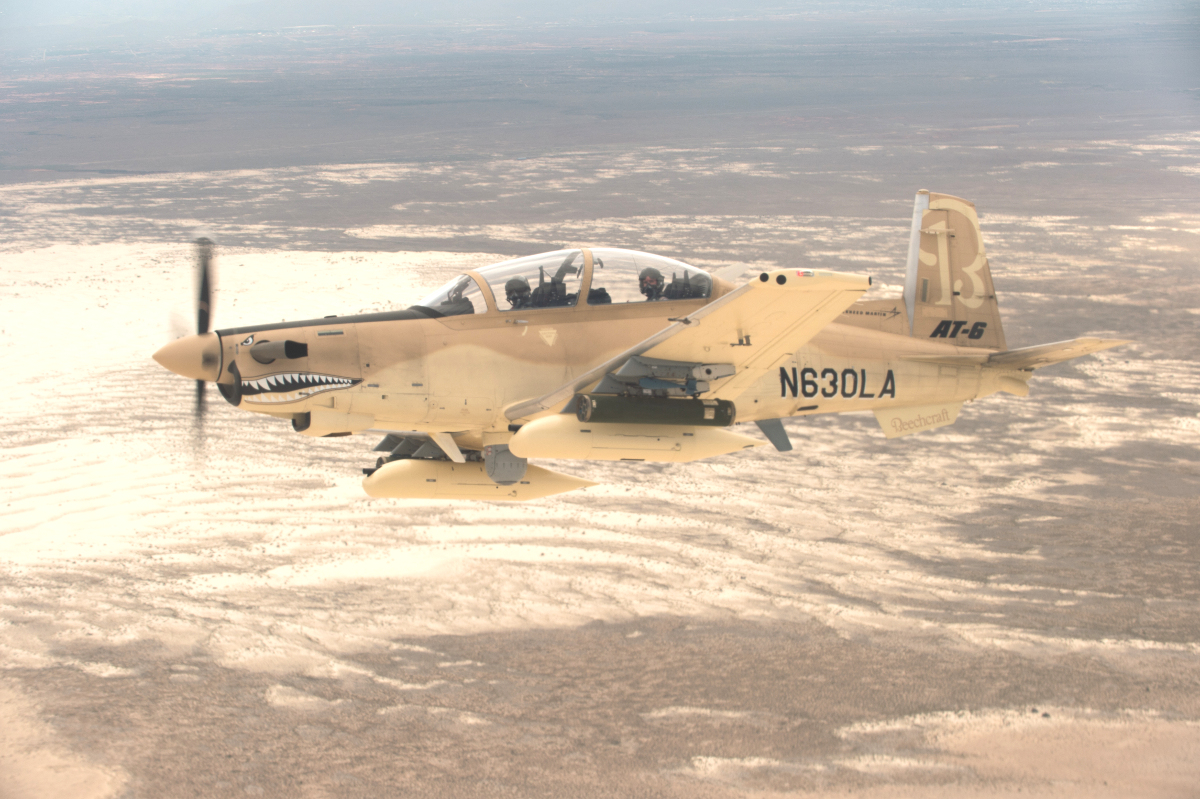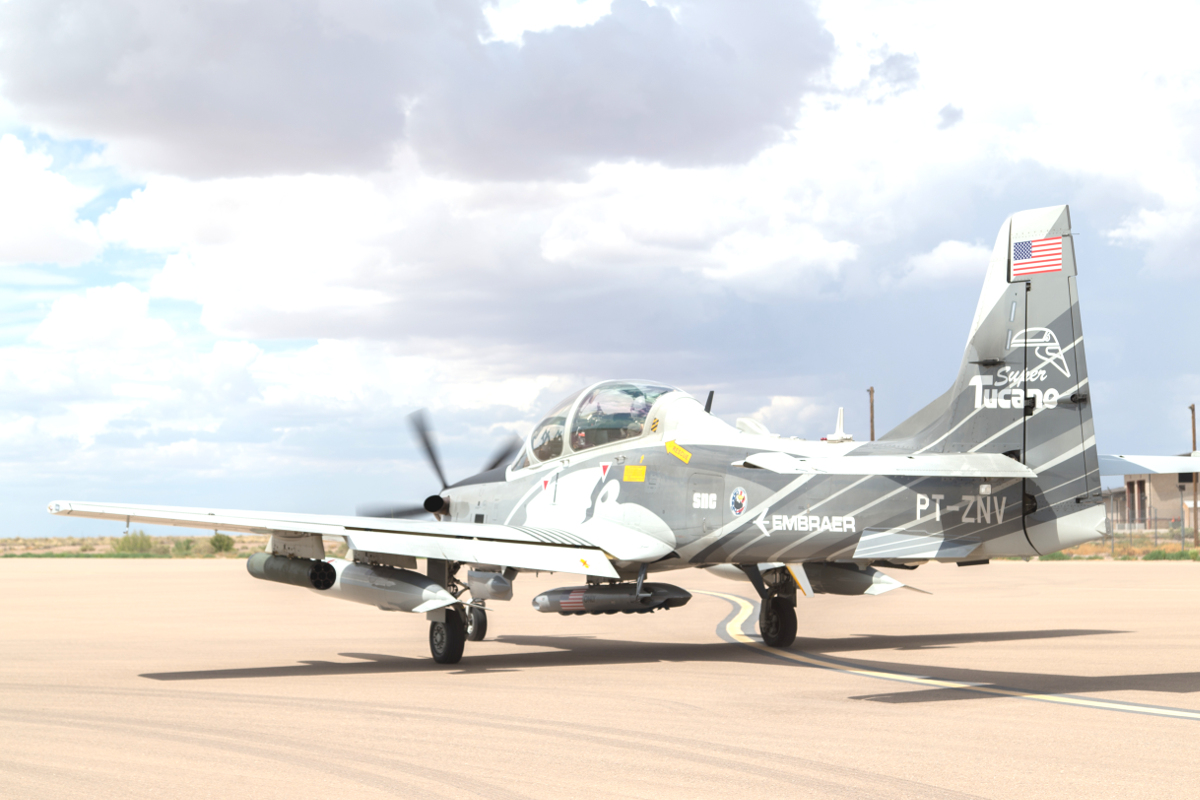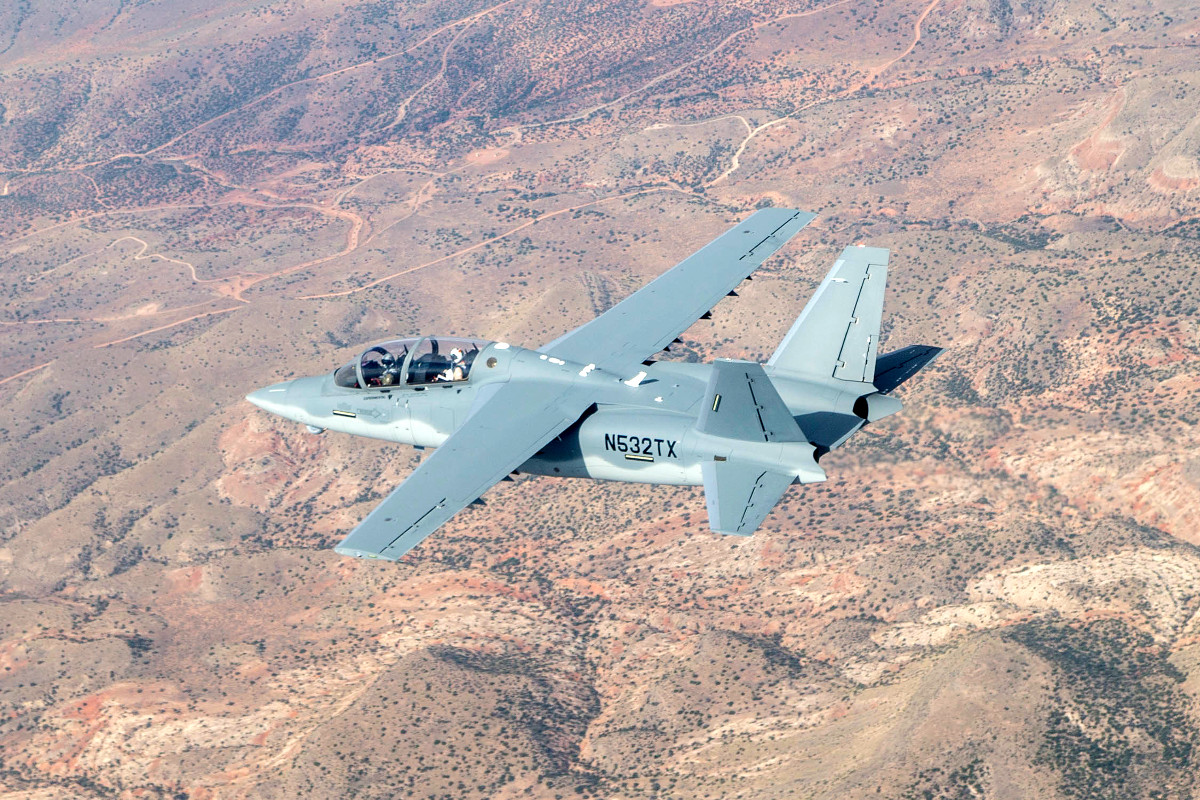The U.S. Air Force has begun to release more information about its ongoing light attack experiment, or OA-X, as well as the first official photos and video of the participants. From how the service is presently describing it, the assessment seems to be equal parts a lead up to a combat field test and marketing for potential future foreign military sales since two of the four aircraft involved don’t qualify for follow-on phases in their present form.
On July 31, 2017, the Air Force kicked off the evaluation at Holloman Air Force in New Mexico. Since then, the four participating aircraft – Sierra Nevada Corporation and Embraer’s A-29 Super Tucano, Textron’s AT-6 Wolverine and Scorpion aircraft, and L-3 and Air Tractor’s OA-802 Longsword – have flown missions during the day and at night, with and without weapons, performing simulated surveillance and light attack missions, as well as more rudimentary flight tests.
“That data is intended to inform strategic decisions,” Secretary of the Air Force Heather Wilson, who is at Holloman for a portion of the assessment, told reporters, according to Defense News. “It will also tell us whether we take this to the next step.”
That next phase of the OA-X project could be an actual experimental deployment to a real combat zone. Though the Air Force has not yet specified any specific countries where it might hold these tests, the most obvious choice for this field evaluation would be either Iraq or Syria, where the planes could operate in relatively permissive environments surveilling and attacking ISIS terrorists. Given the complex and crowded nature of Syrian air space, missions over Iraq might be the better choice.

Right now, it appears that the Air Force is only considering sending what it calls “tier one” participants – those that meet all of its threshold requirements, including a pressurized cockpit with an ejection seat – down range and only if the service is sufficiently impressed by their performance at Holloman. The A-29 and AT-6 are the only participants that meet the tier one requirements. The Scorpion light jet, which cannot operate from unimproved runways, and the OA-802, which lacks an ejection seat, are in a separate tier two category.
“If the two ‘tier ones’ are successful in executing the first phase of the experiment and they want to continue to participate in the experiment, we plan to work with the combatant commanders to utilize both of those resources if they want to go forward,” U.S. Air Force Lieutenant General Arnold Bunch, the service’s top acquisition officer, explained.

Air Force Colonel Michael Pietrucha, the staff lead for light attack at the service’s Air Combat Command who helped draft the original OA-X requirements in 2008, told Defense News that there were already discussions within his command about how a field test might work. Once in the field, the experimental aircraft would undoubtedly take over some missions from ACC’s F-16 Viper and F-15E Strike Eagle multi-role fighter jets, and the A-10 Warthog attack aircraft to a lesser degree. Reducing the burden on higher performance aircraft to free them up for more demanding missions is one of the core arguments for buying a fleet of light attack planes in the first place. They could also perform some of the missions the MQ-1 Predator and MQ-9 Reapers are tasked with today.
“Working with industry, and building on the Combat Dragon series of tests, we are determining whether a commercial off-the-shelf aircraft and sensor package can contribute to the coalition fight against violent extremism,” U.S. Air Force Chief of Staff General David Goldfein explained. “I appreciate industry’s willingness to show us what they have to offer.”
Combat Dragon was the nickname for a field test of the Cessna A-37A Dragonfly light attack jet, derived from the T-37 Tweet trainer, in South Vietnam in 1967. The Air Force revived the nickname for a more recent light attack project, known as Combat Dragon II. This plan at first envisioned a combat evaluation of the A-29 Super Tucano and then ultimately saw the deployment of a pair of heavily modified OV-10G+ Bronco aircraft on loan from NASA to Iraq for operational tests against ISIS. Those aircraft were wildly successful at their mission.
Goldfein has since referred to the OA-X tests as Combat Dragon III, but the plan actually seems to have more in common with a Vietnam-era competitive field test of two other aircraft, the AU-23A Peacemaker and AU-24A Stallion. These aircraft flew combat missions against Communist insurgents in Thailand both as light attackers and miniature gunships during an evaluation called Pave Coin in 1971. The U.S. Air Force subsequently decided not to buy either type and offloaded the remaining planes onto Thailand and Cambodia.

But if the ultimate goal is really a fly-off between the A-29 and AT-6 in actual combat, as it looks to be, it begs the question of why the Air Force has slowed the process down with the evaluation at Holloman at all. We at The War Zone have noted repeatedly that there is a clear and pressing need for this capability.
The Air Force even pitted both aircraft against each other once before when it decided on an aircraft for the Light Air Support (LAS) program. The A-29 won that competition and since 2015 the Air Force has supported the training of Afghan and other allied pilots on the type at Moody Air Force Base in Georgia.
On top of that, the service trains its own fliers on the T-6A Texan II, an unarmed trainer that shares broad commonality with the AT-6 light attacker derivative. As such, both aircraft are already known quantities inside the service in terms of their capabilities and performance and it’s not clear what additional data the USAF might really gain from this assessment or another possible one overseas.

Of course, the Air Force did have specific equipment requirements for OA-X, including service-specific radios and the Link 16 data link, which were different from the A-29s it had helped supply to Afghanistan and Lebanon. However, the service had worked with contractors to train pilots to fly the participating aircraft ahead of the formal start of the OA-X evaluation, which would have uncovered any immediate issues with the basic functionality of the aircraft and their equipment or difficulties in conversion training.
On top of that, the Air Force could have easily reached out to the U.S. Navy or the Air National Guard to help gather necessary information and existing test data, as both of them has extensively evaluated the Super Tucano with more advanced American equipment nearly a decade ago. The results of the Navy’s Imminent Fury experiment was the impetus for the Combat Dragon II program.
Despite Secretary Wilson stressing that the evaluation highlighted “new and faster ways” of doing business, it seems safe to say that the Air Force could have put together a truncated state-side training plan and gotten the aircraft into an operational environment much sooner if that was the objective. It also seems increasingly clear that half the participants never had a realistic chance of advancing to any second phase of the test.
“I believe the tier twos are going to learn from this,” General Bunch said. “They now have our criteria that were in the invitation to participate, so I think they’ll analyze that, they’ll go back and look at their systems, and then they can advance those.”

Instead, for both the tier one and two aircraft, the assessment at Holloman appears to be, at least in part, a marketing event aimed at potential international buyers. The flights give the various companies a prime opportunity to show off their wares for foreign military officials in a structured evaluation that those countries don’t have to pay to run. It’d easily be the first time many of them would get to see the Scorpion, a private venture by Textron, in any context at all. According to Defense News, representatives from Canada, Australia, the United Arab Emirates and Paraguay, were among those out in New Mexico watching the evaluation.
The Pentagon would most likely tap the Air Force to facilitate any foreign military sales deals for these types in the future, too. As already noted, the service has already helped deliver A-29s to Afghanistan and Lebanon, and could be involved in the training of Nigerian pilots as part of a forthcoming deal. There are also reports that The Philippines, another American ally, is finalizing its own plans to purchase six Super Tucanos.
Armed crop dusters, such as the OA-802, are also becoming popular among American allies. In January 2017, the Defense Security Cooperation Agency, the Pentagon’s top weapons broker, announced what has become a controversial sale of L-3 and Air Tractor’s aircraft to Kenya. The United Arab Emirates operates similar planes it purchased from the North Carolina-based firm IOMAX.
Little Paraguay may seem like an outlier in this group, but it is a hub for American-supported counternarcotics and counterterrorism activities in South America’s so-called “Southern Cone” region. The country is reportedly home to one of the two small forward-deployed U.S. military special operations headquarters on the continent. Other American partners in Latin America, such as Colombia, already fly the Super Tucano for light attack missions.
The OA-X tests could offer a chance for the competitors to pitch their aircraft to countries that might not have seriously considered this sort of capability, as well. As with the U.S. Air Force, Australia and Canada could be interested in a light attack aircraft as a low-cost alternative to sending their multi-role F/A-18 Hornet fighter jets
on operations abroad. Both countries routinely engage in counterterrorism and peacekeeping missions overseas that could call for surveillance and light attack missions in permissive environments.
With all this in mind, it remains as unclear as ever what the Air Force’s real goal with the OA-X experiment actually is. As it stands now, it looks like the most likely outcomes of the first phase of the evaluation, if there are any definitive outcome at all, could be a combat fly-off between the A-29 and AT-6 and an uptick in light attack aircraft sales to U.S. allies around the world. Regardless, it seems the road to an operational light attack aircraft fleet within the USAF’s inventory remains a meandering and uphill one.
Contact the author: joe@thedrive.com
